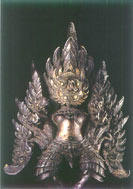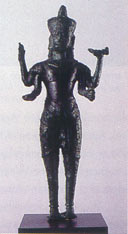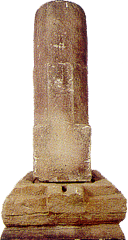Religious Symbolism
 |
Bronze chariot
fitting showing Garuda clutching the naga |
Every surviving Khmer building had a religious purpose. The reason
is simply that only temples and other religious foundations merited
the use of permanent materials – brick. sandstone laterite
- and all else has decomposed over the centuries. Even the palace
of the king at Angkor was timber.
To appreciate fully these monuments built by the Khmers between
approximately the 7th and the 13th centuries, it is important to
know something of the Hindu and Buddhist cults to which they were
dedicated. The buildings and their artefacts were single-mindedly
designed for worship. "Most of the objects to be met are devotional
in nature, created with religious and utilitarian rather then aesthetic
motives; and they were fashioned by craftsmen who worked in a tradition
which dictated strict canons of iconography and manufacture, and
who could never have understood the meaning of the word 'artist'
as it is used today" This is Roy Craven writing about Khmer
artefacts, and his comments apply equally to the architecture. None
of the work of this period lends itself to being judged on modern
grounds of taste, even though the results may well inspire and delight.
Over the Khmer Empire as a whole, Hinduism dominated until the
end of the 12th century, when it gave way to Mahayana Buddhism,
although not for long Both came from India, and although the exact
means are in doubt, it is likely that Indian traders were the first
to introduce their religion to Cambodia Hinduism over the centuries
had changed its focus, with different gods in ascendancy, but by
the time it reached the Khmers there were two principal cults-that
of Vishnu and that of Shiva. These two gods were part of the Hindu
Trinity (the third was Brahma) which commanded a pantheon of lesser
gods and had inter alia a complex relationship. They were connected
in many of the same myths, acted partly in concert, partly in rivalry.
 |
| Small bronze
statue of the 4 - armed Vishnu |
Vishnu four-armed and holding a conch discus mace and lotus is
the Protector His fundamental role in cosmology is to conserve the
status qua in the universe. He takes a particular interest in human
affairs, so much so that on occasions he takes on an earthly form
to intervene. These various forms of Vishnu are known as avatar,
and the two most famous are Rama, eponymous hero of the Ramayana
epic, and Krishna. Both of these personalities embody a kind of
magical ideal; they are true heroes, physically and morally. Other
avatar of Vishnu include a lion, wild boar, dwarf, turtle and fish.
In the range of Hindu deities, Vishnu is essentially kindly and
well-disposed to man, and this accounts for a large part of the
god's popularity as a cult.
 |
| Stone linga
representing the essence of Shiva from Sung Noen, Nakhon Ratchasima. |
Shiva contrasts with Vishnu in a number of ways.His main cosmological
role is os the Destroyer he brings each kalpa, or world cycle, to
an end with his dance of destruction However, Shiva's force is by
no means is a negative one, as in modern physics, Hindu cosmology
envisaged the universe is having a cyclic nature. The end of each
kalpa brought about by Shiva's dance is also the beginning of the
next. Rebirth follows destruction In the cosmological sense, Shiva's
power’s are more fundamental than Vishnu’s.
The Khmers worshipped Shiva primarily in the form of a linga- a
pillar, usually in stone, derived from a phallus and representing
the essence of the god. The linga, mounted in a pedestal representing
an equally abstract yoni, or female organ, occupied the shrine of
a temple, and was the focus of rituals conducted by the priests.
The other forms in which Shiva was represented were as the 10 armed
god dancing the universe to destruction, as the supreme yogi, or
ascetic, and riding with his consort Uma on his steed, the bull
Nandin.
|